Violent weather developed once again across the heart of the U.S. late last week (Friday, May 31, 2013) as a line of severe storms stretched from Oklahoma and into the U.S. Midwest. Nine people died, including three professional storm chasers, with a report of at least 75 people injured in the storms. Eight of the nine deaths occurred in vehicles. Storms fired up from small showers to intense supercells in a matter of 30 minutes. The environment had been primed for severe weather as instability, moisture content, and wind shear was high across Oklahoma. These ingredients created a large supercell on the southern end of the line of storms, which created at least five tornadoes across the Oklahoma City area. Not only did it produce tornadoes, but the event also produced large hail the size of baseballs, damaging winds over 70 miles per hour, and heavy rain that caused significant flash flooding: plenty of reasons for people to stay home and avoid the roads. Complicating the situation was that the storm pushed in during evening rush hour traffic. In this post, we will not only talk about the event that occurred, but also look at what went wrong and what went right. Will we learn from our mistakes?
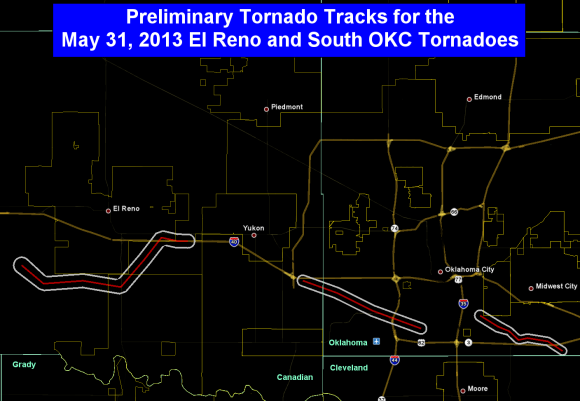
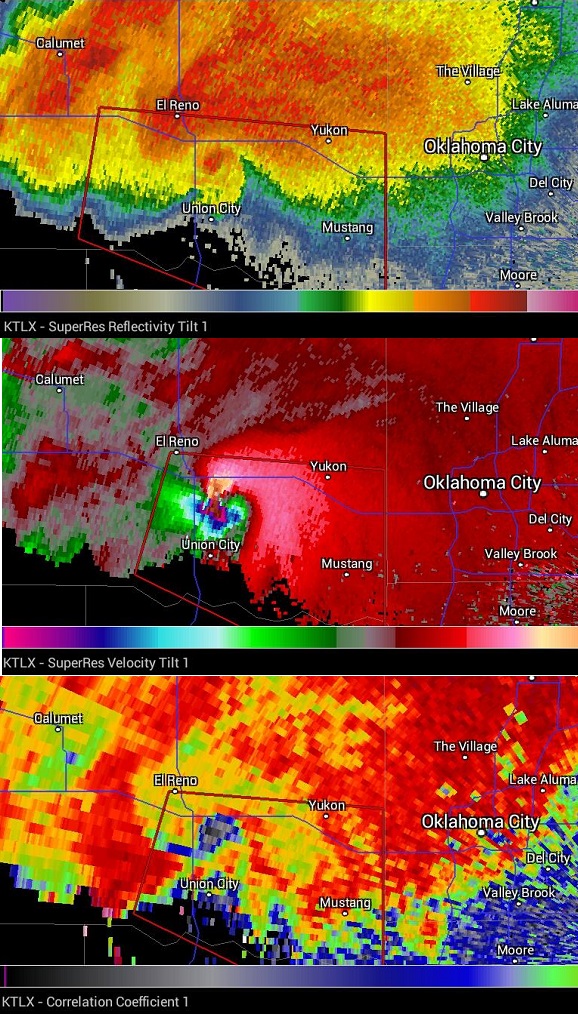
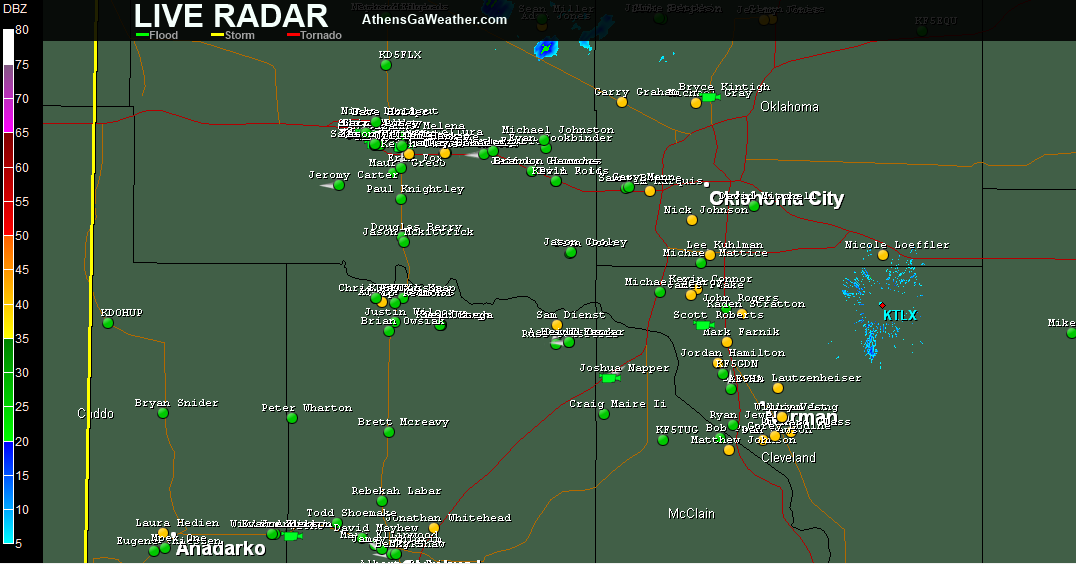
Given the number of tornados in Oklahoma and elsewhere in the U.S. Midwest on May 31, it’s fair to say that there were plenty of storm chasers on the road Friday evening. Check out the illustration above, to see just how many in central Oklahoma. Whenever moderate or high risks are issued, a large number of storm chasers focus on one area. That means a lot of vehicles on the roads, driving in such a way as to keep a tornado in their sights. For this reason alone, some storm chasers avoid chasing on days like these simply because the roads are too crowded, and there is less freedom to travel safely.
In particular, there was one supercell that storm chasers should have probably left alone. The EF-3 tornado in El Reno, Oklahoma was large and wrapped in rain. It was difficult to see, and it was a beast. The track was slightly odd, as it was shifting just south of due east, but then decided to take a left turn and head towards I-40. Among the deaths from this storm were Tim Samaras from Discovery Channel’s Storm Chasers, along with his son and chaser Carl Young. Read more about Samaras’ work and his death, here.
Other storm chasers suffered minor injuries and damage to their vehicles, including Reed Timmer, also known for the show Storm Chasers on Discovery.
Mike Bettes and the Weather Channel’s Tornado Hunt crew took a direct hit from the El Reno tornado as it pushed nearly due north onto Interstate-40. The tornado picked up their SUV, flipped it over multiple times, threw it 200 feet and slightly flattened it like a pancake. Bettes suffered injuries to his hands, but, otherwise, he and his crew were able to escape with only relatively minor cuts, bruises, and scratches.
Storm chaser Brandon Sullivan and his team were also caught off guard by the tornado near El Reno, Oklahoma. The video below illustrates the raw terror of being caught in a tornado. These storm chasers were fortunate; they survived this tornado.


The May 31 storm over El Reno produced other tornadoes as well, including an EF-0 tornado that hit parts of Moore, Oklahoma, the suburb of Oklahoma City where 24 deaths occurred from tornados on May 20.
A big and concering problem about the May 31, 2013 storms in Oklahoma was that at least one local television station in the Oklahoma City area, while reporting that weather was imminent, mentioned that going underground or leaving your house was the best way to survive the storm. This is wrong. When tornados are imminent, going to your vehicle and driving on the roads is the last thing you should do. In my post from Friday afternoon – before the storms broke – I described in detail the possibility of severe weather for Friday evening. Included in the post was a graphic from the Norman, Oklahoma National Weather Service Office via twitter:
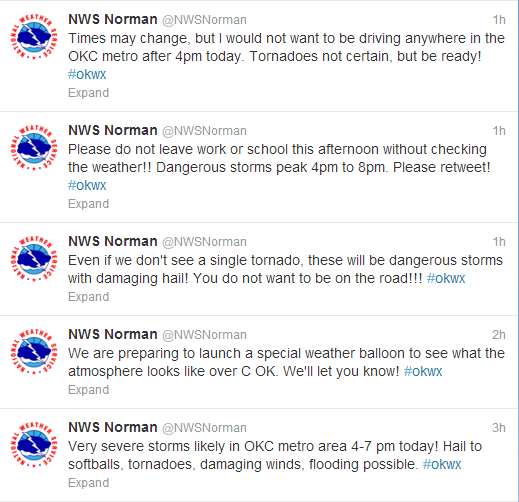
Notice the top tweet mentioned in the graphic above. The NWS specifically states:
Times may change, but I would not want to be driving anywhere in the OKC metro after 4pm today. Tornadoes not certain, but be ready! #okwx
You should never evacuate your home while under a tornado warning unless you live in a mobile home and are trying to get to a nearby shelter (one of only the few exceptions).
There was plenty of warning well in advance of these storms, and the local NWS offices and the Storm Prediction Center did an excellent job issuing watches and warnings and keeping the public safe. However, mixed messages from local television stations can cause confusion, and people may be more likely to listen to their local TV meteorologist than reading a tweet or checking NOAA’s website.
On May 31, traffic was horrible across the central Oklahoma region. Dick McGowen posted the image below online, showing central Oklahoma traffic trying to head south; this same areas would encounter flash flooding, violent winds, and possible tornadoes a short time later. Two interstates – I-35 and I-40 – were congested with traffic, and the cars were not moving while the severe storms were pushing in. Something is incredibly wrong about the picture below.
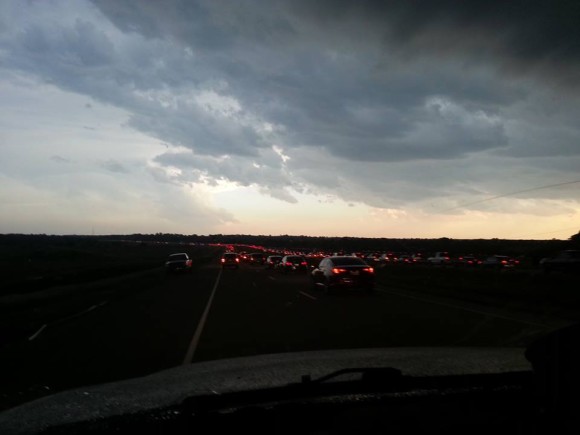
If a tornado warning is imminent, don’t evacuate. Instead, go to the lowest floor of whatever building you’re in, near the central part of the building, and stay away from windows. You want to be surrounded by as many walls as you can be.
There have been plenty of times where violent tornadoes struck populated areas, and all the people were able to survive. Driving away from the storm is not the right thing to do. During the May 31 tornadoes in Oklahoma, many people were driving home from work or school. When unfortunate timing like that occurs, try to can leave work early or consider staying put until the storm passes.
In the case of the May 31 storms in Oklahoma, flooding was also a major concern. Rainfall totals were over six inches in many areas across central Oklahoma, and some cars were submerged under flood waters. What to do if you do find yourself on the road, when flash floods are occuring? Keep a cool head, and never drive into moving flood waters. If you encounter a flood, turn around.

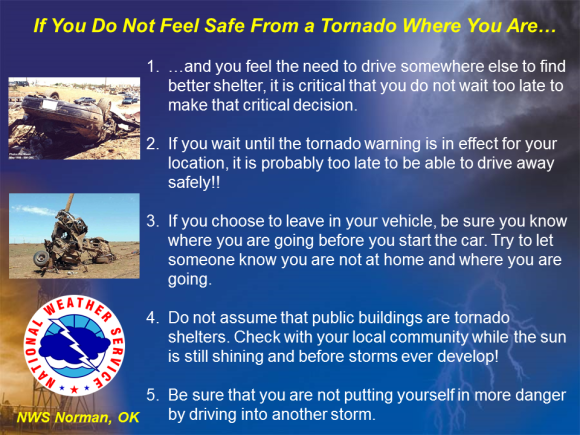
Norman, Oklahoma NWS posted the image above via their social media feeds several hours before the severe weather outbreak occurred on May 31. It directly states that – if you find yourself in a risk area with the potential to see strong and violent tornadoes – the only reason you should leave and evacuate is when storms have not developed.
Harold Brooks, Senior Scientist in the Forecast Research and Development Division at NOAA’s National Severe Storms Laboratory in Norman, Oklahoma, and an AMS Fellow wrote:
As a factual statement, claiming that EF5 tornadoes can’t be survived above ground is wrong. After the 3 May 1999 tornado that hit Moore, Oklahoma, survey work indicated that 1% of people who were in houses that were rated F4 or F5 were killed, as reported by Hammer and Schmidlin. They don’t differentiate between the F4 and F5 in the paper, but it is exceedingly unlikely that all of the people in F5 homes died. In the 20 May 2013 tornado, the Briarwood Elementary School was rated EF5 and there were no fatalities there … Violent tornadoes are very dangerous, but they do not bring certain death.
Jason Samenow of the Washington Post’s Capital Weather Gang sums it up well in his June 1 post titledThe Day that Should Change Tornado Actions and Storm Chasing Forever:
Most likely, the vehicle deaths were preventable. Their occurrence should squash the idea that trying to flee a tornado in a car is a good idea. And storm chasers – who pursued the tornadic storms much too closely – set a poor example and need to re-examine their priorities.
Bottom line: Nine people died in central Oklahoma on May 31, 2013 as severe weather struck the area. Eight of those were vehicle deaths. Always go to your safe spot, whether that’s underground or toward the center of a building (away from windows), during a tornado. People can and do survive even the most powerful EF-5 tornadoes. Plus most of the tornadoes that occur are generally weaker tornadoes (EF-0 to EF-2). Prayers go out to all of the people impacted by the storms in the United States on May 31, 2013. Remember: When the weather is bad, stay indoors. I know I will.











